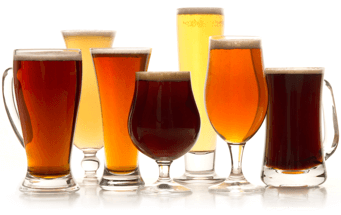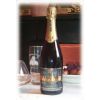Brouwerij De Landtsheer - Malheur Black Chocolate
-
ABV:
12% -
Int’l Bittering Units (IBUs):
33 - 36
It doesn't look like a bar of chocolate, does it? Come to think of it, it resembles a bottle of wine - Champagne - more than a beer. There are some places in the world where "The Wine of the Country" is beer. If you have a warm temperate climate, like Italy, France, Spain or Portugal, you grow grapes or other fruits, and make wine. If your have a temperate cool climate, you grow grain, especially barley, and brew beer, as they do in the Czech Republic, Germany, Belgium, Great Britain and Ireland. If the world were a tidier place, the Alps would divide wine and beer. Instead, when the snow melts in the mountains, and the waters irrigate the foothills and plains, the grapes and the grain often face each other, from the Moravia Valley of Eastern Europe to the Pacific Northwest.
Crush the grapes, ferment the sugary juice, and you have wine; a simple, unsophisticated, beverage, I reckon (some of my colleagues do not agree). Grain takes up less rain, and is therefore not very juicy. It has to be steeped in water and dried in a kiln (in other words, malted), then infused in a vessel like a huge coffee filter, before its fermentable sugars are surrendered.
The wine-maker balances the sweetness and acidity of his grape juice with the vanilla-like compounds and tannins that reside in the oak of his barrels. Beer is so delicate that it can be overwhelmed by oak. Only a tiny minority of brave brewers risk that, mainly in Belgium and the United States.
The sweetness of malted barley is typically balanced by the dryness of spices or herbs. The most usual herb is the hop, a member of the cannabis family. The hop is a vine that bears small, highly aromatic, cone-like blossoms rich in resins and essential oils. The compounds that naturally occur in the hop are also found in citrus fruits, bay leaves and mint, for example. Each variety of hop imparts to the beer a different balance and intensity of aromas and flavors. The Saaz hop of Bohemia reminds me of chamomile; the Tettnang, from the shores of Lake Constance, suggests fragrant pipe tobacco; the Fuggle, from the English side of the Welsh border, has perhaps a touch of aniseed; the Cascade, from Washington State, bites like the zest of grapefruit. When these varieties are cultivated in other regions, their aromas and flavors will subtly change.
Not only do the grape and the grain often inhabit adjoining regions, their meeting places are often especially hoppy. Certain areas of the Champagne region grow grapes and barley, while hops straddle the borders of France and Belgium. These meeting places often produce the most interesting wines and beers, each influencing the other. This is evident where Moravia meets Bohemia; where the breweries and wineries of Franconia are near neighbors; in the Rhineland; where France and Belgium meet; and where those countries face England across the Channel; and not the least in towns like Hopland, California and points north.
That litany of liquid delights flows from east to west. In the middle is Belgium. This small nation is smack in the centre of Europe's beer belt. Looked at from north to south, it is also at the meeting point: where beer and wine seem to blend; where precise Germanic languages rub against passionate Latin tongues; where Protestant and Catholic attitudes toward food and drink, work and play, seek an accommodation. The cool north of Europe industrialized before the warm south. Coal miners and steel workers drank beer because it washed away dust, quenched thirst, and was a source of energy. It was also cheaper: grain is more resilient, and grows in a wider belt. Wine grapes are fussier about soil and more vulnerable to weather. The captains of industry enjoyed expensive wines.
The wines of the South were described in books for the benefit of their wealthy, well-educated patrons. In the literature of wine, Britain is over-represented, but the early authors often seemed to be writing for people with a level of knowledge similar to their own. . This was not true of the most eminent contemporary wine-writer in Britain, Hugh Johnson. His book “The World Atlas of Wine”, without compromising his writing style, opened the universe of the grape to a far wider audience. He explained the manifold pleasures of wine to people who knew only "chablis". Their counterparts in the world of beer know only a very distant interpretation of the Pilsner style: Bud, Coors, Miller Genuine Draft, all the light beers, Corona, Harp, Heineken, Beck's, Asahi Super Dry, Foster's, are all in this same style.
Yet beer is made in styles as different as a Chardonnay is from a Zinfandel, a Sauternes from a Port, a Sherry from a Champagne. When I started writing about beer, something of this was understood in Germany, Belgium and Britain, but only by the more aware drinker. Of those countries, Belgium affords the most wine-like treatment to beer: maturing it in wood; offering it in Champagne bottles; serving it in Burgundy samplers, flutes and chalices; and feeling a passion for it.
The Belgians really love beer. The man who makes this beer, Emmanuel 'Manu' De Landtsheer, had a grandfather who was a brewer. The brewery went out of business during the time of Manu's father. Manu could not deal with the idea of his family not having a brewery. So he built a new one, and when I first visited him there he told me that I just had to come on to the roof, had to follow him up. We climbed up and looked across the flat fields of Flanders. He showed me the church next to which his great grandfather had a brewery, and the village in which his uncle had a brewery, and another spot with the remnants of his cousin’s brewery. The family history of brewing was terribly important to him. The thing about Belgium is that there is great history and heritage, plus a very innovative approach to making beer.
Manu created a Champagne-style beer. It actually uses the same remuage and degorgement procedures that Champagne does. The French are not very keen, by the way, about the Belgians making beers with these Champagne characteristics. The French are very protective of the appellation descriptions of their sparkling wines. The Belgians are not to be dissuaded. They call their beer “The Burgundy of Belgium”. You might think that the creation of a Champagne beer amounts to quite a lot of innovation for a new brewery, but not Manu. He also wanted to make a beer that went with Belgian chocolates. So he produced his champagne-style beer in a dark version: Malheur Black Chocolate.
Belgium is not a country in which to diet. Do that before you go. While there, adopt their attitude: eat, drink, be merry, and take a philosophical view of any possible consequences. I mention this because this brewery’s beers have the brand name Malheur, and anyone who speaks French might know that it means “misfortune”. Why call a beer Misfortune? It's a joke, informed by that philosophical view. I can’t really imagine any product in my country, or the United States, being given such a name.
It is also odd, but not altogether unusual, that this beer has a French name. French is the language of the southern part of Belgium, which is called Wallonia; this beer is made in the northern part of Belgium, known as Flanders. There, they speak Flemish, which is a version of Dutch. Don’t worry about language. Just go there and speak English, and drink beer that is somehow cosmopolitan yet also deeply rooted in the local traditions of the country.
This beer has an incredible chocolate taste, yet there isn’t any chocolate in it. How do you get the taste without using chocolate? Manu uses chocolate malt. That is a common term in the industry for a malt that is highly roasted but not carbonized,. It creates chocolatey flavors, rather than the burned espresso taste that a stout would have.
This beer pours with a great head, as many Belgian beers do. Sometimes in Belgium they actually wet the glass so that the head won’t become like an ice cream sundae. Wouldn’t this be great to have with a dessert, can you imagine a dark chocolate mousse, a terrine of black chocolate, even death-by-chocolate. What a way to go.
On the aroma it has little vanilla and chocolate characteristics. It’s not vanilla, it’s not chocolate, it’s not champagne, it’s beer. Maybe a taste of toasted nuts, roasted nuts, which reminds me of the other element in the production of this beer. It is aged in wine barriques, wooden wine barrels, and they are toasted in the way that they would be for certain oaky wines.
Twelve percent alcohol. That sounds a big hit and for a beer it is. Not a lot for a wine though, is it? I think that many people get confused about this. They often think that somehow beer is more fattening than wine. In fact, the fattening element is the alcohol. Most beers are less alcoholic than wine, and this one is just about the same.
It has a lot of length to it, as well. The flavors actually develop on the tongue. Nutty, roasted chestnut, toasty flavors like those in champagne from the champagne yeast that is used in the second refermentation. It’s got a beautiful balance of sweetness and dryness. Maybe a chocolate beer sounds a bit cloying, but the acidity balances it out very well. I would be hard-pressed to say whether this is a sweet beer or a dry beer.
There you are: beer is every bit as complex as wine. Perhaps packaging it rather like Champagne and sharing a bed with wine in the remuage and degorgement, is a way of making that point. I don’t have any chocolate mousse at the moment, but I’ll enjoy myself with tasting this for a while. A votre santé, or proost, as they say in Flemish.


Unmatched Variety by style, brewery & country
Choose from Five different Beer Clubs offering unmatched variety by brewery,
country of origin, and beer style to suit your specific tastes.


